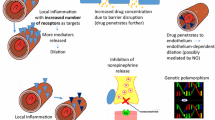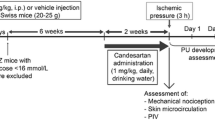Abstract
Background
Topical αd- and α2-adrenoreceptor (ADRA1 and 2) agonists are effective in alleviating permanent vasodilation and facial erythema associated with rosacea by inducing skin vasoconstriction. Although β-adrenoreceptor (ADRB) antagonists are used off-label for rosacea, pharmacological and pharmacodynamic data pertaining to these receptors in skin micro-vessels are lacking.
Objectives
To analyse the expression of different adrenergic receptors and their contribution to vasoreactivity in skin micro-vessels.
Materials & Methods
Small arteries (500–800 µm) and arterioles (<200 µm) were studied in human foreskin tissue. Specifically, ADR-A1, -A2, -B1 and -B2 expression was assayed by immunofluorescence, polymerase chain reaction (PCR), and western blotting. Small skin artery reactivity was evaluated using ex vivo myography (500–800 µm) or a visible microscope perfusion system with precision-cut skin slices (<200 µm).
Results
ADRB2 was the most highly expressed receptor in small skin arteries and arterioles, followed by ADRA2. ADRA2 activation via brimonidine-induced vasoconstriction was greater in skin arterioles than in small skin arteries, and more potent than that with norepinephrine (NE). The use of prazosin (ADRA1 inhibitor) partially attenuated brimonidine-induced vasoconstriction, indicating some activation of ADRA1 by brimonidine, at least at 10-µM concentrations. Small skin arteries and arterioles, pre-treated with prazosin and stimulated with NE, exhibited ADRB2-mediated vasodilation, which was inhibited by the beta blockers, propranolol or timolol.
Conclusion
This study shows that ADRB2 is predominantly expressed in small skin arteries and arterioles, and that ADRBs plays a functional role in vasodilation. The data presented here indicate that ADRBs can be a therapeutic target for the treatment of rosacea.
Similar content being viewed by others
References
Alexis AF, Callender VD, Baldwin HE, Desai SR, Rendon MI, Taylor SC. Global epidemiology and clinical spectrum of rosacea, highlighting skin of color: Review and clinical practice experience. J Am Acad Dermatol 2019; 80: 1722–1729 e1727.
Del Rosso JQ. Management of facial erythema of rosacea: what is the role of topical alpha-adrenergic receptor agonist therapy? J Am Acad Dermatol 2013; 69: S44–56.
Tan J, Blume-Peytavi U, Ortonne JP, et al. An observational cross-sectional survey of rosacea: clinical associations and progression between subtypes. Br J Dermatol 2013; 169: 555–62.
Schwab VD, Sulk M, Seeliger S, et al. Neurovascular and neuroimmune aspects in the pathophysiology of rosacea. J Investig Dermatol Symp Proc 2011; 15: 53–62.
Del Rosso JQ. Advances in understanding and managing rosacea: part 1: connecting the dots between pathophysiological mechanisms and common clinical features of rosacea with emphasis on vascular changes and facial erythema. J Clin Aesthet Dermatol 2012; 5: 16–25.
Del Rosso JQ, Baldwin H, Webster G, American A, Rosacea S. American Acne & Rosacea Society rosacea medical management guidelines. J Drugs Dermatol 2008; 7: 531–3.
Steinhoff M, Buddenkotte J, Aubert J, et al. Clinical, cellular, and molecular aspects in the pathophysiology of rosacea. J Investig Dermatol Symp Proc 2011; 15: 2–11.
Hieble JP. Subclassification and nomenclature of alpha- and beta-adrenoceptors. Curr Top Med Chem 2007; 7: 129–34.
Craige H, Cohen JB. Symptomatic treatment of idiopathic and rosacea-associated cutaneous flushing with propranolol. J Am Acad Dermatol 2005; 53: 881–4.
Okwundu N, Cline A, Feldman SR. Difference in vasoconstrictors: oxymetazoline vs. brimonidine. J Dermatolog Treat 2019: 1–7.
Shanler SD, Ondo AL. Successful treatment of the erythema and flushing of rosacea using a topically applied selective alpha1-adrenergic receptor agonist, oxymetazoline. Arch Dermatol 2007; 143: 1369–71.
Hrometz SL, Edelmann SE, McCune DF, et al. Expression of multiple alpha1-adrenoceptors on vascular smooth muscle: correlation with the regulation of contraction. J Pharmacol Exp Ther 1999; 290: 452–63.
Arribas S, Marin J, Ponte A, Balfagon G, Salaices M. Norepinephrine-induced relaxations in rat aorta mediated by endothelial beta adrenoceptors. Impairment by ageing and hypertension. J Pharmacol Exp Ther 1994; 270: 520–7.
Hjemdahl P, Belfrage E, Daleskog M. Vascular and metabolic effects of circulating epinephrine and norepinephrine. Concentration-effect study in dogs. J Clin Invest 1979; 64: 1221–8.
Stephens DP, Aoki K, Kosiba WA, Johnson JM. Nonnoradrenergic mechanism of reflex cutaneous vasoconstriction in men. Am J Physiol Heart Circ Physiol 2001; 280: H1496–1504.
Spoendlin J, Voegel JJ, Jick SS, Meier CR. Antihypertensive drugs and the risk of incident rosacea. Br J Dermatol 2014; 171: 130–6.
Milara J, Ballester B, Morell A, et al. JAK2 mediates lung fibrosis, pulmonary vascular remodelling and hypertension in idiopathic pulmonary fibrosis: an experimental study. Thorax 2018; 73: 519–29.
Ortiz JL, Milara J, Juan G, et al. Direct effect of cigarette smoke on human pulmonary artery tension. Pulm Pharmacol Ther 2010; 23: 222–8.
Perrigouard C, Peltre B, Cribier B. A histological and immunohistological study of vascular and inflammatory changes in rosacea. Ann Dermatol Venereol 2013; 140: 21–9.
Rosina P, Zamperetti MR, Giovannini A, Chieregato C, Girolomoni G. Videocapillaroscopic alterations in erythematotelangiectatic rosacea. J Am Acad Dermatol 2006; 54: 100–4.
Steinhoff M, Schmelz M, Schauber J. Facial Erythema of Rosacea — Aetiology, Different Pathophysiologies and Treatment Options. Acta Derm Venereol 2016; 96: 579–86.
Del Rosso JQ, Gallo RL, Tanghetti E, Webster G, Thiboutot D. An evaluation of potential correlations between pathophysiologic mechanisms, clinical manifestations, and management of rosacea. Cutis 2013; 91: 1–8.
Yamasaki K, Di Nardo A, Bardan A, et al. Increased serine protease activity and cathelicidin promotes skin inflammation in rosacea. Nat Med 2007; 13: 975–80.
Grosshans E, Michel C, Arcade B, Cribier B. Rilmenidine in rosacea: a double-blind study versus placebo. Ann Dermatol Venereol 1997; 124: 687–91.
Wilkin JK. Effect of subdepressor clonidine on flushing reactions in rosacea. Change in malar thermal circulation index during provoked flushing reactions. Arch Dermatol 1983; 119: 211–4.
Piwnica D, Rosignoli C, de Menonville ST, et al. Vasoconstriction and anti-inflammatory properties of the selective alpha-adrenergic receptor agonist brimonidine. J Dermatol Sci 2014; 75: 49–54.
Hsu CC, Lee JY. Pronounced facial flushing and persistent erythema of rosacea effectively treated by carvedilol, a nonselective beta-adrenergic blocker. J Am Acad Dermatol 2012; 67: 491–3.
Sun D, Huang A, Mital S, et al. Norepinephrine elicits beta2-receptor-mediated dilation of isolated human coronary arterioles. Circulation 2002; 106: 550–5.
Crandall CG, Etzel RA, Johnson JM. Evidence of functional beta-adrenoceptors in the cutaneous vasculature. Am J Physiol 1997; 273: H1038–1043.
Hodges GJ, Kellogg DL, Johnson JM. Effect of skin temperature on cutaneous vasodilator response to the beta-adrenergic agonist isoproterenol. J Appl Physiol 1985 2015; 118: 898–903.
Overgaard CB, Dzavik V. Inotropes and vasopressors: review of physiology and clinical use in cardiovascular disease. Circulation 2008; 118: 1047–56.
Chilian WM. Adrenergic vasomotion in the coronary microcirculation. Basic Res Cardiol 1990; 85(Suppl 1): 111–20.
Chilian WM. Functional distribution of alpha 1- and alpha 2-adrenergic receptors in the coronary microcirculation. Circulation 1991; 84: 2108–22.
Bylund DB, Chacko DM. Characterization of alpha2 adrenergic receptor subtypes in human ocular tissue homogenates. Invest Ophthalmol Vis Sci 1999; 40: 2299–306.
Jarajapu YP, Johnston F, Berry C, et al. Functional characterization of alpha1-adrenoceptor subtypes in human subcutaneous resistance arteries. J Pharmacol Exp Ther 2001; 299: 729–34.
Burke J, Schwartz M. Preclinical evaluation of brimonidine. Surv Ophthalmol 1996; 41(Suppl 1): S9–18.
Chen L, Tsai TF. The role of beta-blockers in dermatological treatment: a review. J Eur Acad Dermatol Venereol 2018; 32: 363–71.
Logger JGM, Olydam JI, Driessen RJB. Use of beta-blockers for rosacea-associated facial erythema and flushing: A systematic review and update on proposed mode of action. J Am Acad Dermatol 2020: S0190–9622.
Storch CH, Hoeger PH. Propranolol for infantile haemangiomas: insights into the molecular mechanisms of action. Br J Dermatol 2010; 163: 269–74.
Mak IT, Weglicki WB. Potent antioxidant properties of 4-hydroxyl-propranolol. J Pharmacol Exp Ther 2004; 308: 85–90.
Bakar O, Demircay Z, Yuksel M, Haklar G, Sanisoglu Y. The effect of azithromycin on reactive oxygen species in rosacea. Clin Exp Dermatol 2007; 32: 197–200.
Gerber PA, Buhren BA, Steinhoff M, Homey B. Rosacea: The cytokine and chemokine network. J Investig Dermatol Symp Proc 2011; 15: 40–7.
Acknowledgments and disclosures
This work was supported by the grants SAF2017-82913-R (JC), Fondo Europeo de Desarrollo Regional (FEDER) and Instituto de salud carlos III FIS PI17/02158 (JM), JR18/00050 (JM), PI20/01363 (JM), CIBERES (CB06/06/0027) and TRACE (TRA2009-0311) from the Spanish Government and by research grants from the Regional Government Prometeo 2017/023/UV (JC), from “Generalitat Valenciana”. Funding entities did not contribute to the study design or data collection, analysis and interpretation nor to the writing of the manuscript. Conflicts of interest: none.
Author information
Authors and Affiliations
Corresponding author
About this article
Cite this article
Morell, A., Milara, J., Gozalbes, L. et al. β2-adrenoreceptors control human skin microvascular reactivity. Eur J Dermatol 31, 326–334 (2021). https://doi.org/10.1684/ejd.2021.4068
Accepted:
Published:
Issue Date:
DOI: https://doi.org/10.1684/ejd.2021.4068




